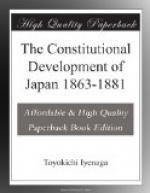1. To ascertain the political condition of the country at and after the advent of foreigners in 1853.
2. To describe the form of government of the Restoration.
3. To examine the state of commerce, industry, education and social life of Japan at each stage of her political transformations.
4. To recount the constitutional changes from the Restoration to the Promulgation of the New Constitution.
As a novice in travel marks the broad outlines, the general features and more important products of the country he visits for the first time, so I shall dwell upon the historic landmarks of Japanese constitutional development. This development no writer, native or foreign, has yet attempted to trace. I shall withstand as much as possible the temptation to refer to the multitude of events which are more or less associated with the constitutional movement. I shall endeavor to ascertain from the edicts, decrees, and proclamations of the Emperor, from the orders and manifestos of the Shogun, from the native authors and journals, from the memorials and correspondence of prominent men, both native and foreign, the trend of our constitutional development. I shall also endeavor to note the leading ideas and principles which, after manifesting themselves in various forms, have at last crystallized into the New Constitution of Japan.
CHAPTER I.
Beginning of the constitutional movement.
The constitutional movement of Japan began in a spontaneous agitation of the whole body politic when the nation was irritated by the sudden contact with foreigners. The sense of national weakness added a force to this agitation. Had not the foreigners come, the Restoration might have been effected, feudalism might have been abolished, but the new Japanese constitution would hardly have seen the day. Had the government of Japan at the time of the advent of foreigners been in the strong hand of a Taiko or an Iyeyasu, the rulers might have been greatly exercised by the extraordinary event, but public opinion for reform would hardly have been called forth, and the birth of constitutional liberty would long have been delayed. As the vices of King John and the indifference and ignorance of the first two Georges of England begat the strength and hope of the English Parliament, so the public opinion of Japan sprouted out of the ruins of the Shogunate regime. We must therefore seek for the beginning of the Constitutional Movement of Japan in the peculiar circumstances in which she found herself between 1853 and 1868.
The advent of Commodore Perry in 1853 was to Japan like the intrusion of a foreign queen into a beehive. The country was stirred to its depth. Let us note what a native chronicler[1] says about the condition of Japan at the arrival of Perry:




